Accepted Scientific Name: Epithelantha micromeris (Engelm.) F.A.C.Weber in Bois
Dict. Hort. [Bois] 2: 804. 1898 Britton & Rose, Cactaceae, 3: 93, fig. 102. 1922 Bois
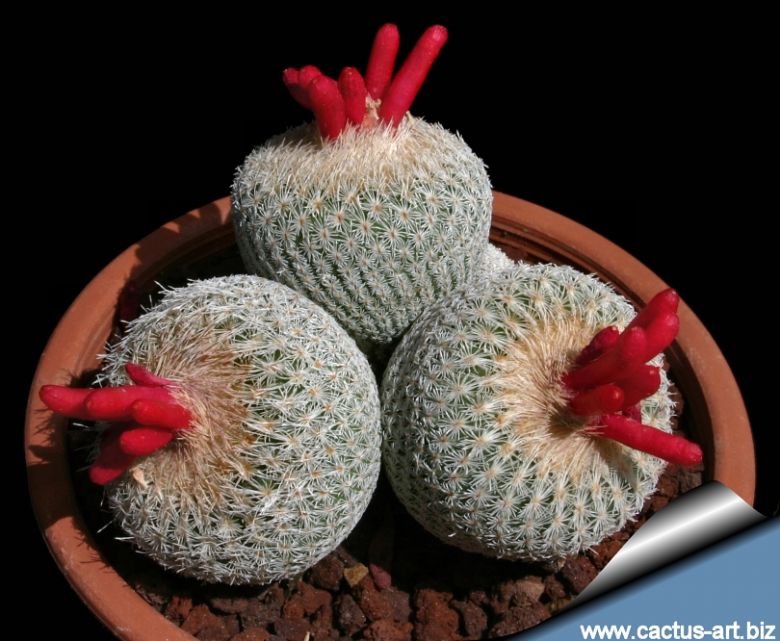
Echinocactus micromeris (Epithelantha micromeris) Photo by: Cactus Art
SB125 Arteagas Canyon, Saltillo, Coahuila, Mexico. The rather small flowers are often followed by attractive
red fruits which contrast nicely with the spines
Origin and Habitat: USA - Arizona (Santa Cruz and Cochise County) New Mexico (Hildago and Sandoval Co, From Sierra and Chaves to Eddy Co), western Texas. Mexico (northern Chihuahua).
The endemic Mexican taxa have relatively large flowers like those of Epithelantha bokeiSN|12641]]SN|12641]].
Altitude: It grows from 500 to 1800 metres in elevation.
Habitat and Ecology: Widespread in desert grasslands and woodlands It grows on crevices, coarse gravel, cliffs, sedimentary calcareous rock (rarely igneous) substrates on hills and ridges in the Chihuahuan Desert. These cacti are normally found in small clusters because the seeds fall nearby. Also wind, rain, and wildlife help with the dispersal of seeds. The species has an exceptionally large range, high number of individuals and low threat, therefore it is listed as Least Concern.
Synonyms:
See all synonyms of Epithelantha micromeris
Common Names include:
ENGLISH: Button Cactus, Living Rocks
SPANISH (Español): Tapone, Mulatto
TARAHUMARA: Híkuli mulato
Description: Epithelantha micromerisSN|6936]]SN|6936]] is a miniature globose cactus, erect, unbranched or in small clumps, not deep-seated in substrate, appearing ashy grey and relatively rough in general aspect.
Stem: Unsegmented, mostly spheric or obovoidal, rarely cylindric, often flat-topped with a depressed centre, 1-5(-9)cm tall and up to 2-4 (-7,5) cm in diameter, occasionally more; surface completely obscured by spines; cortex and pith are not mucilaginous.
Tubercles: Numerous, not confluent into ribs, hemispheric or short cylindric, very low, ca. 1(-3) mm long arranged in tight spirals around the plant.
Areoles: Small at tips of tubercles, 1 mm long, nearly circular, elliptic when distended by flower or fruit, slightly woolly when young, copiously woolly only at sexually mature stem apex; areolar glands absent;
Spines: 20-35(-40) white to ashy grey 2-5 mm long, appressed on sides of stems, straight, terete, slender, innocuous, in 1-3 superimposed series except for a longer (4-12 mm) and erect adaxial tuft on the top, on sexually mature stem apex often greyish or purplish white, frequently with brown bases, collectively forming brown spots at the centre of each spine cluster. The upper radials on the young tubercles longer and connivent over the apex, narrowly clavate, the upper half finally falling off. Spine clusters at the sides of stem 4-5(-7) mm in diameter. Smooth or microscopically roughened by break-up of epidermis, not distinguishable as radial and central spines. In fully adult plants, the distal portions of the longest spines are worn, leaving the apex of the plant covered with short, innocuous spines.
Roots: Diffuse (usually) or tap-root (in some populations) also tuberlike (see: Epithelantha pachyriza )
Flower: Inconspicuous, funnelform diurnal, borne at adaxial margins of spine clusters in the plant top. Only partly opened just distal portion visible, as they barely stick out above the wool obscured by longer spines at stem apex. Outer tepals entire or sparsely erose-fimbriate; Inner tepals 5-8 per flower, pink to white (rarely yellow), (1-)2-6(-9) × 3(-5) mm; stamens 15-16; ovary smooth, scales, hairs, and spines absent; stigma lobes (2-)3-4(-6), white, to 1 mm.
Blooming season:: Flowers late winter-early spring (Feb-Apr).
Fruits: Indehiscent, bright red, thin narrowly cylindric, 3-20 × 2-3(-5) mm, weakly succulent, soon drying and papery, smooth, spineless; pulp absent; floral remnant deciduous. Fruiting late spring-early summer (Apr-Jun).
Seeds: Blackish, obliquely hemispheric reticulated in 0,5-1,5 mm diameter.
Remarks: Epithelantha micromerisSN|6936]]SN|6936]] var. micromeris has some of the smallest flowers among cactus species. Unlike other taxa in this genus, it is Autogamous. Its fruit are known in mexico as "chilitos."
Subspecies, varieties, forms and cultivars of plants belonging to the Epithelantha micromeris group
 Epithelantha micromeris (Engelm.) F.A.C.Weber in Bois: Miniature globose cactus, unbranched or in small clumps. Produces small pink flowers followed by attractive red fruits . Spines are white or greysh, innocuous and appressed on sides of stems.
Epithelantha micromeris (Engelm.) F.A.C.Weber in Bois: Miniature globose cactus, unbranched or in small clumps. Produces small pink flowers followed by attractive red fruits . Spines are white or greysh, innocuous and appressed on sides of stems. Epithelantha micromeris f. cristata hort.: This is a miniature cactus that makes a nice and tangled cluster of fine crests. The stem surface is completely obscured by small pectinated ashy-grey to white spines.
Epithelantha micromeris f. cristata hort.: This is a miniature cactus that makes a nice and tangled cluster of fine crests. The stem surface is completely obscured by small pectinated ashy-grey to white spines. Epithelantha micromeris var. dickisoniae hort.: Minute clustering cactus of doubtful status (but common in cultivation), it shows similarities with Epithelantha micromeris subsp. polycephala and Epithelantha pachyrhiza. Spines are whitish turning to a brownish tinge in adult plant's crown. Roots: Tuberose.
Epithelantha micromeris var. dickisoniae hort.: Minute clustering cactus of doubtful status (but common in cultivation), it shows similarities with Epithelantha micromeris subsp. polycephala and Epithelantha pachyrhiza. Spines are whitish turning to a brownish tinge in adult plant's crown. Roots: Tuberose. Epithelantha micromeris f. elongata (Backeb.) Bravo: It has elongated stems and a thick tap-root. It is intermediate between E. micromeris and E. pachyrhiza. Distribution: Ramos Arispe, Coahuila, Mexico.
Epithelantha micromeris f. elongata (Backeb.) Bravo: It has elongated stems and a thick tap-root. It is intermediate between E. micromeris and E. pachyrhiza. Distribution: Ramos Arispe, Coahuila, Mexico. Epithelantha micromeris subs. greggii (Engelm.) N.P.Taylor: This subspecies has a rough, somewhat bristly appearance with iIndividual stems up to 5 cm or more in diameter,. Spines are chalky white to reddish brown. Distribution: Northern Mexico, especially Saltillo, Coahuila.
Epithelantha micromeris subs. greggii (Engelm.) N.P.Taylor: This subspecies has a rough, somewhat bristly appearance with iIndividual stems up to 5 cm or more in diameter,. Spines are chalky white to reddish brown. Distribution: Northern Mexico, especially Saltillo, Coahuila. Epithelantha micromeris subs. greggii f. cristata: crested form.
Epithelantha micromeris subs. greggii f. cristata: crested form. Epithelantha micromeris var. neomexicana n.n.: This is the population found in New Mexico (USA) but this taxon is not easily recognizable from other Epitelantha micromeris (if not the same identical plant)
Epithelantha micromeris var. neomexicana n.n.: This is the population found in New Mexico (USA) but this taxon is not easily recognizable from other Epitelantha micromeris (if not the same identical plant) Epithelantha micromeris subs. pachyrhiza (W.T.Marshall) N.P.Taylor: It has tuberousroots and a stem only partly obscured by the white to orange-tan spines; Distribution: Strictly endemic of southeast and northeast of Saltillo.
Epithelantha micromeris subs. pachyrhiza (W.T.Marshall) N.P.Taylor: It has tuberousroots and a stem only partly obscured by the white to orange-tan spines; Distribution: Strictly endemic of southeast and northeast of Saltillo. Epithelantha micromeris subs. pachyrhiza f. cristata
Epithelantha micromeris subs. pachyrhiza f. cristata Epithelantha micromeris subs. polycephala (Backeb.) Glass: Clustering miniature cactus; an old plant may have more than 100 heads, and be 10 cm of diameter. Spines are grey/whitish, pastel or ocre. Distribution: it occurs in a limited area of Coahuila.
Epithelantha micromeris subs. polycephala (Backeb.) Glass: Clustering miniature cactus; an old plant may have more than 100 heads, and be 10 cm of diameter. Spines are grey/whitish, pastel or ocre. Distribution: it occurs in a limited area of Coahuila. Epithelantha micromeris var. rufispina (Bravo) Backeb.: Minute globular cactus, becoming somewhat elongated when old. the spines are numerose up to 40 whitish all radials, turning to a grey-reddish or brownish tinge in adult plants crown. The spine base is reddish.
Epithelantha micromeris var. rufispina (Bravo) Backeb.: Minute globular cactus, becoming somewhat elongated when old. the spines are numerose up to 40 whitish all radials, turning to a grey-reddish or brownish tinge in adult plants crown. The spine base is reddish.- Epithelantha micromeris var. texensis n.n.: This is the population found in Texas (USA) but this taxon is not easily recognizable from other Epitelantha micromeris (if not the same identical plant)
 Epithelantha micromeris var. texensis f. cristata hort.: Crested form.
Epithelantha micromeris var. texensis f. cristata hort.: Crested form. Epithelantha micromeris subs. unguispina (Boed.) N.P.Taylor: It is a little larger than the standard form. Stem globular, up to 6 cm, often clumping over time. It generally has a small projecting black-tipped central spine, 4-5mm long. Origin: Near Monterrey, Nuevo Leon, south into San Luis Potosi.
Epithelantha micromeris subs. unguispina (Boed.) N.P.Taylor: It is a little larger than the standard form. Stem globular, up to 6 cm, often clumping over time. It generally has a small projecting black-tipped central spine, 4-5mm long. Origin: Near Monterrey, Nuevo Leon, south into San Luis Potosi.
Bibliography: Major references and further lectures
1) Edward Anderson “The Cactus family” Timber Press, Incorporated, 2001
2) James Cullen, Sabina G. Knees, H. Suzanne Cubey "The European Garden Flora Flowering Plants: A Manual for the Identification of Plants Cultivated in Europe, Both Out-of-Doors and Under Glass" Cambridge University Press, 11/Aug/2011
3) David R Hunt; Nigel P Taylor; Graham Charles; International Cactaceae Systematics Group. "The New Cactus Lexicon" dh books, 2006
4) N. L. Britton, J. N. Rose: “The Cactaceae. Descriptions and Illustrations of Plants of the Cactus Family.” Volume III, The Carnegie Institution of Washington, Washington 1922
5) A. Michael Powell, James F. Weedin "Cacti of the Trans-Pecos & Adjacent Areas" Texas Tech University Press, 2004
6) Pierre C. Fischer "70 Common Cacti of the Southwest" Western National Parks Association, 1989
7) Brian Loflin, Shirley Loflin "Texas Cacti: A Field Guide" Texas A&M University Press, 26/ott/2009
8) Del Weniger "Cacti of the Southwest: Texas, New Mexico, Oklahoma, Arkansas, and Louisiana" University of Texas Press, 1969
9) Del Weniger "Cacti of Texas and Neighboring States: A Field Guide" University of Texas Press, 1984
10) Leo J. Chance "Cacti and Succulents for Cold Climates: 274 Outstanding Species for Challenging Conditions" Timber Press, 19/giu/2012
11) Jeff Nugent "Permaculture Plants: Agaves and Cacti" permacultureplants, 1999
12) Douglas B. Evans "Cactuses of Big Bend National Park" University of Texas Press, 1998
13) Flora of North America Editorial Committee "Flora of North America: North of Mexico. Magnoliophyta: Caryophyllidae, part 1" Oxford University Press, 1993
14) Carolyn Dodson "A Guide to Plants of the Northern Chihuahuan Desert" UNM Press, 15/feb/2012
15) Edgar Lamb, Brian Michael Lamb "Colourful cacti and other succulents of the deserts" Blandford Press, 1974
16) Corral-Díaz, R., Fitz Maurice, B, Fitz Maurice, W.A., Goettsch, B.K., Heil, K. & Terry, M. 2013. Epithelantha micromeris. In: IUCN 2013. "IUCN Red List of Threatened Species." Version 2013.2. <www.iucnredlist.org>. Downloaded on 19 February 2014.
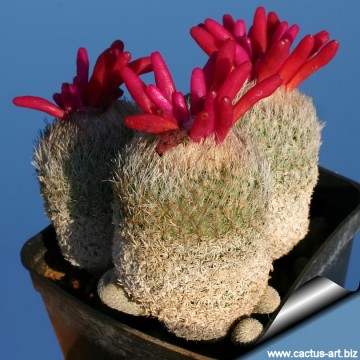 Echinocactus micromeris (Epithelantha micromeris) Photo by: Cactus Art
Echinocactus micromeris (Epithelantha micromeris) Photo by: Cactus Art In habitat in limestone crevices at Grutas de García, Nuevo León (forma unguispina?) (Epithelantha micromeris) Photo by: Agócs György
In habitat in limestone crevices at Grutas de García, Nuevo León (forma unguispina?) (Epithelantha micromeris) Photo by: Agócs György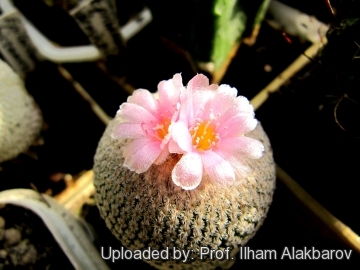 Echinocactus micromeris (Epithelantha micromeris) Photo by: Prof. Ilham Alakbarov
Echinocactus micromeris (Epithelantha micromeris) Photo by: Prof. Ilham Alakbarov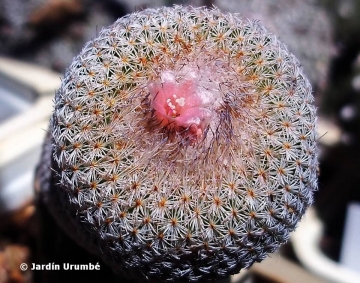 Echinocactus micromeris (Epithelantha micromeris) Photo by: Alexander Arzberger
Echinocactus micromeris (Epithelantha micromeris) Photo by: Alexander Arzberger Echinocactus micromeris (Epithelantha micromeris) Photo by: Cactus Art
Echinocactus micromeris (Epithelantha micromeris) Photo by: Cactus Art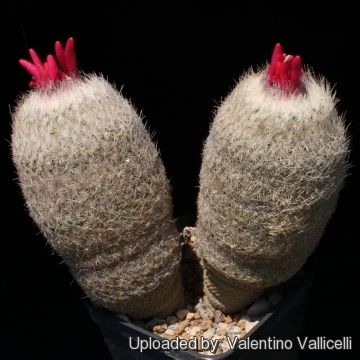 DJF714.41 Lincoln Co., NM. USA (Epithelantha micromeris) Photo by: Valentino Vallicelli
DJF714.41 Lincoln Co., NM. USA (Epithelantha micromeris) Photo by: Valentino Vallicelli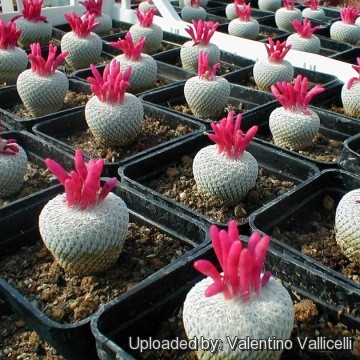 Echinocactus micromeris (Epithelantha micromeris) Photo by: Valentino Vallicelli
Echinocactus micromeris (Epithelantha micromeris) Photo by: Valentino Vallicelli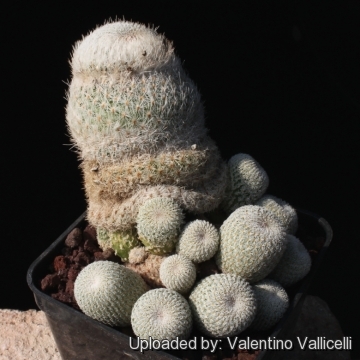 JM101 (Collector: Josef Mikulas) locality: Sitting Bull Canyon, New Mexico, USA (Epithelantha micromeris) Photo by: Valentino Vallicelli
JM101 (Collector: Josef Mikulas) locality: Sitting Bull Canyon, New Mexico, USA (Epithelantha micromeris) Photo by: Valentino VallicelliCultivation and Propagation: Although regarded as a choice and difficult plant, in cultivation it is relatively easy. It needs a particularly well-draining soil mix (rot prone). Water sparingly.
Frost Tolerance: Depending on the variety, will handle -12° C (Temperature Zone: USDA 8-11)
Sun Exposure: Light shade to full sun.
Propagation: Seeds, offsets.
Your Photos
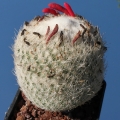
by Valentino Vallicelli
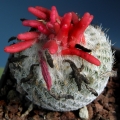
by Valentino Vallicelli
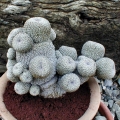
by Valentino Vallicelli

by Valentino Vallicelli
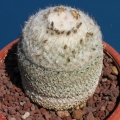
by Valentino Vallicelli
























